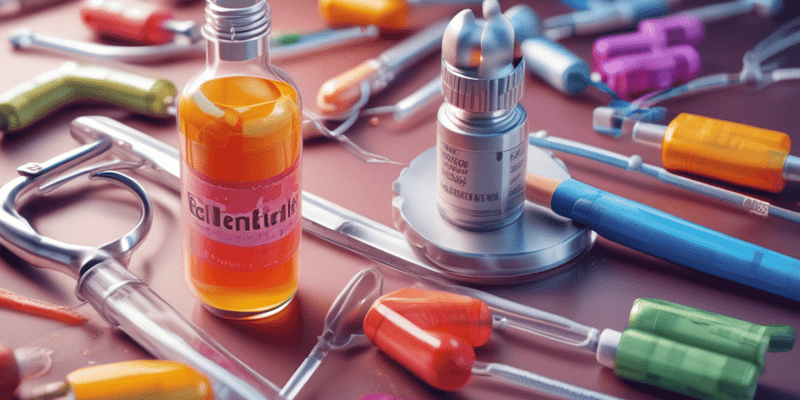30 Questions
What is the primary purpose of coating a tablet?
To hide the taste of the tablet's components
What type of capsules are primarily used for oils and active ingredients dissolved or suspended in oil?
Soft-shelled capsules
What is the term for a type of tablet designed to dissolve in water, producing carbon dioxide gas?
Effervescent tablet
What is the term for a type of oral dosage form that dissolves slowly in the mouth, typically used for local effects?
Lozenge
What is the main difference between coated and uncoated tablets?
The presence of an additional coating layer
What is the primary advantage of using capsules over tablets?
Capsules are more versatile in terms of filling materials
What type of oral liquid is typically flavored and sweetened to mask the unpleasant taste of the active ingredients?
Syrup
What is the term for a type of oral dosage form that dissolves quickly in the mouth, typically used for systemic effects?
Sublingual tablet
What is the primary factor that determines the form of a drug?
The physical state of the formulation
What is the term for a type of oral dosage form that is designed to dissolve in the mouth, but not in the stomach?
Buccal tablet
What is the primary purpose of lozenges in medication?
To administer remedies slowly to the mouth and throat
What is the main difference between an elixir and a syrup?
An elixir contains antimicrobial preservatives, while a syrup does not
What is a characteristic of suspensions in oral preparations?
They contain solid particles that are sufficiently large for sedimentation
What is the purpose of effervescent tablets?
To provide a rapid dissolution of indigestion or cough remedies
What is the main difference between an ointment and a cream?
Ointments have a high viscosity, while creams have a low viscosity
What is the primary characteristic of emulsions in oral preparations?
They are composed of two unmixable solutions
What is the purpose of syrup in oral preparations?
To provide a concentrated aqueous solution of sugar
What is the main difference between a vial and an ampoule?
Vials are used for multiple use, while ampoules are used for single use
What is the purpose of infusion solutions in pharmaceuticals?
To replace water, sugar, and salt in patients who are ill or having an operation
What is the primary characteristic of tablets in oral preparations?
They are solid preparations
What is the primary characteristic of a gel in terms of its physical properties?
It is a semi-solid emulsion in an alcohol base
What is the main difference between a solution and a lotion?
A solution is more emollient, while a lotion is thicker
What is the primary function of a transdermal patch?
To deliver a drug through a precise time-release method
What is the main characteristic of a suppository?
It is a solid dosage form that melts or dissolves at body temperature
What is the primary function of an inhaler?
To deliver a drug directly to the lungs
What is the main characteristic of an aerosol spray?
It is a type of dispensing system that creates an aerosol mist of liquid particles
What is the primary function of a nebulizer?
To break up medical solutions/suspensions into small aerosol droplets
What is the primary characteristic of ophthalmic drops?
They have a special viscosity and pH buffer
What is the main difference between a transdermal patch and a suppository?
A transdermal patch is used to deliver a drug through the skin, while a suppository is used to deliver a drug through the rectal route
What is the primary characteristic of a gel, in terms of its effect on the skin?
It is drying
Study Notes
Dosage Forms
- A dosage form is a product designed for administration to the patient for diagnosis or treatment of disease, and is a mixture of active drug components and non-drug components.
Factors Determining Dosage Forms
- Physical state of formulation (affected by light or heat)
- Chemical stability of drug (e.g., insulin cannot be given orally)
- Taste and odor of drug
- Site of the disease
- Different medical conditions (e.g., persistent nausea and vomiting)
- Patient desire
Oral Dosage Forms
Solid Oral Dosage Forms
- Tablets:
- Hard, compressed medication in round, oval, or square shape
- Coated or uncoated
- Coatings: hide taste, make smoother, resist environment, extend duration in body
- Buccal and sublingual tablets
- Capsules:
- Hard-shelled (dry, powdered ingredients, or granules)
- Soft-shelled (oils and active ingredients dissolved or suspended in oil)
Lozenges
- Solid preparation consisting of sugar and gum for slow administration of indigestion or cough remedies in the mouth and throat
Effervescent Tablets
- Uncoated tablets containing acid substances (like citric acid) and bicarbonates dissolved in water for rapid dissolution
Liquid Oral Preparations
Syrups
- Concentrated aqueous solution of sugar (usually sucrose)
- Homogeneous mixture
- Vehicle may contain ethanol and antimicrobial preservatives for stability
Suspensions
- Heterogeneous mixture containing solid particles that sediment (e.g., Amoxicillin suspension)
Emulsions
- Two unmixable solutions (e.g., oil in water)
Paranteral Dosage Forms (Injections)
- Sterile solutions, suspensions, or emulsions in a suitable aqueous or non-aqueous vehicle
- Includes:
- Vials (with a rubber cover, for multiple use)
- Ampoules (glass, single use)
- Infusion solutions (IV fluids)
Topical Dosage Forms
- Ointments:
- Greasy, thick oil (80% oil, 20% water) for external application to skin and mucous membranes
- Not water-washable
- Creams:
- Emulsion of oil and water (approximately equal proportions) for external application to skin and mucous membranes
- Thicker than lotion, high patient acceptance, washable with water
- Lotions:
- Thicker than solutions, emollient in nature
- Oil mixed with water (20%:80%)
- Gels:
- Semi-solid emulsion in an alcohol base
- Melts at body temperature, drying
- Formed from gelator, solvent, active drug, and excipients
Transdermal Patches
- Precise time-released method of delivering a drug
- Release of active component controlled by diffusion through a membrane
Rectal Dosage Forms
- Suppositories:
- Solid dosage forms that melt or dissolve at body temperature
- Used for hormones, antipyretics, and analgesics
Respiratory Dosage Forms
- Inhalers:
- Handheld devices for breathing medicine directly to the lungs
- Deliver dry powder or spray of medication
- Commonly used for asthma, COPD, and other respiratory problems
- Aerosol Sprays:
- Dispensing system creating an aerosol mist of liquid particles
- Used with a can or bottle containing product and propellant under pressure
- Nebulizers:
- Use oxygen, compressed air, or ultrasonic power to break up medical solutions/suspensions into small aerosol droplets for inhalation
Ophthalmic Dosage Forms
- Ophthalmic Drops:
- Special viscosity and pH buffer
This quiz covers the basics of lozenges, effervescent tablets, and liquid oral preparations in pharmacy. Learn about the composition and uses of lozenges, and the differences between syrups and other liquid oral preparations.
Make Your Own Quizzes and Flashcards
Convert your notes into interactive study material.
Get started for free



